Bo Yan
MicroVQA++: High-Quality Microscopy Reasoning Dataset with Weakly Supervised Graphs for Multimodal Large Language Model
Nov 14, 2025Abstract:Multimodal Large Language Models are increasingly applied to biomedical imaging, yet scientific reasoning for microscopy remains limited by the scarcity of large-scale, high-quality training data. We introduce MicroVQA++, a three-stage, large-scale and high-quality microscopy VQA corpus derived from the BIOMEDICA archive. Stage one bootstraps supervision from expert-validated figure-caption pairs sourced from peer-reviewed articles. Stage two applies HiCQA-Graph, a novel heterogeneous graph over images, captions, and QAs that fuses NLI-based textual entailment, CLIP-based vision-language alignment, and agent signals to identify and filter inconsistent samples. Stage three uses a MultiModal Large Language Model (MLLM) agent to generate multiple-choice questions (MCQ) followed by human screening. The resulting release comprises a large training split and a human-checked test split whose Bloom's level hard-sample distribution exceeds the MicroVQA benchmark. Our work delivers (i) a quality-controlled dataset that couples expert literature with graph-based filtering and human refinement; (ii) HiCQA-Graph, the first graph that jointly models (image, caption, QA) for cross-modal consistency filtering; (iii) evidence that careful data construction enables 4B-scale MLLMs to reach competitive microscopy reasoning performance (e.g., GPT-5) and achieve state-of-the-art performance among open-source MLLMs. Code and dataset will be released after the review process concludes.
Meta-Inverse Reinforcement Learning for Mean Field Games via Probabilistic Context Variables
Sep 04, 2025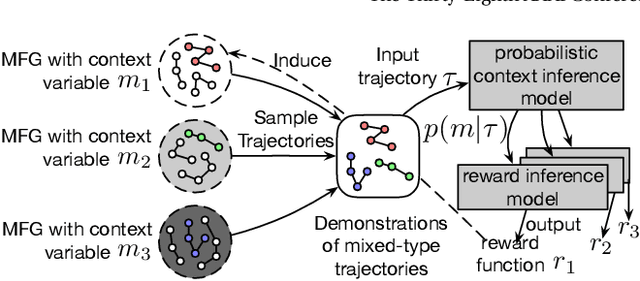


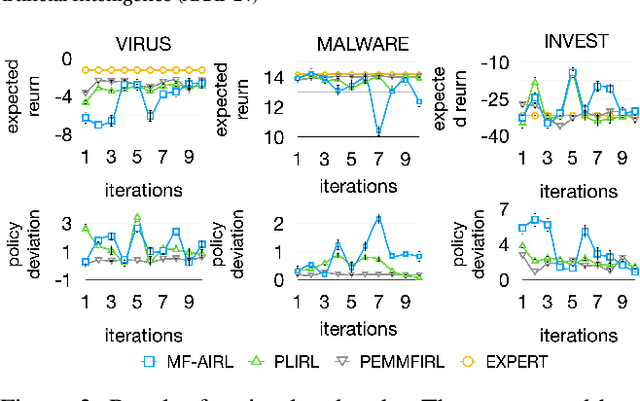
Abstract:Designing suitable reward functions for numerous interacting intelligent agents is challenging in real-world applications. Inverse reinforcement learning (IRL) in mean field games (MFGs) offers a practical framework to infer reward functions from expert demonstrations. While promising, the assumption of agent homogeneity limits the capability of existing methods to handle demonstrations with heterogeneous and unknown objectives, which are common in practice. To this end, we propose a deep latent variable MFG model and an associated IRL method. Critically, our method can infer rewards from different yet structurally similar tasks without prior knowledge about underlying contexts or modifying the MFG model itself. Our experiments, conducted on simulated scenarios and a real-world spatial taxi-ride pricing problem, demonstrate the superiority of our approach over state-of-the-art IRL methods in MFGs.
Unifying Segment Anything in Microscopy with Multimodal Large Language Model
May 16, 2025Abstract:Accurate segmentation of regions of interest in biomedical images holds substantial value in image analysis. Although several foundation models for biomedical segmentation have currently achieved excellent performance on certain datasets, they typically demonstrate sub-optimal performance on unseen domain data. We owe the deficiency to lack of vision-language knowledge before segmentation. Multimodal Large Language Models (MLLMs) bring outstanding understanding and reasoning capabilities to multimodal tasks, which inspires us to leverage MLLMs to inject Vision-Language Knowledge (VLK), thereby enabling vision models to demonstrate superior generalization capabilities on cross-domain datasets. In this paper, we propose using MLLMs to guide SAM in learning microscopy crose-domain data, unifying Segment Anything in Microscopy, named uLLSAM. Specifically, we propose the Vision-Language Semantic Alignment (VLSA) module, which injects VLK into Segment Anything Model (SAM). We find that after SAM receives global VLK prompts, its performance improves significantly, but there are deficiencies in boundary contour perception. Therefore, we further propose Semantic Boundary Regularization (SBR) to prompt SAM. Our method achieves performance improvements of 7.71% in Dice and 12.10% in SA across 9 in-domain microscopy datasets, achieving state-of-the-art performance. Our method also demonstrates improvements of 6.79% in Dice and 10.08% in SA across 10 out-ofdomain datasets, exhibiting strong generalization capabilities. Code is available at https://github.com/ieellee/uLLSAM.
MM-Skin: Enhancing Dermatology Vision-Language Model with an Image-Text Dataset Derived from Textbooks
May 09, 2025Abstract:Medical vision-language models (VLMs) have shown promise as clinical assistants across various medical fields. However, specialized dermatology VLM capable of delivering professional and detailed diagnostic analysis remains underdeveloped, primarily due to less specialized text descriptions in current dermatology multimodal datasets. To address this issue, we propose MM-Skin, the first large-scale multimodal dermatology dataset that encompasses 3 imaging modalities, including clinical, dermoscopic, and pathological and nearly 10k high-quality image-text pairs collected from professional textbooks. In addition, we generate over 27k diverse, instruction-following vision question answering (VQA) samples (9 times the size of current largest dermatology VQA dataset). Leveraging public datasets and MM-Skin, we developed SkinVL, a dermatology-specific VLM designed for precise and nuanced skin disease interpretation. Comprehensive benchmark evaluations of SkinVL on VQA, supervised fine-tuning (SFT) and zero-shot classification tasks across 8 datasets, reveal its exceptional performance for skin diseases in comparison to both general and medical VLM models. The introduction of MM-Skin and SkinVL offers a meaningful contribution to advancing the development of clinical dermatology VLM assistants. MM-Skin is available at https://github.com/ZwQ803/MM-Skin
Non-Uniform Class-Wise Coreset Selection: Characterizing Category Difficulty for Data-Efficient Transfer Learning
Apr 17, 2025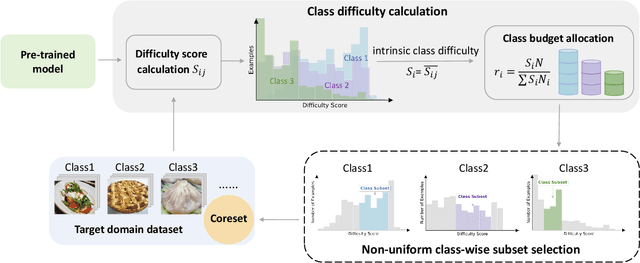
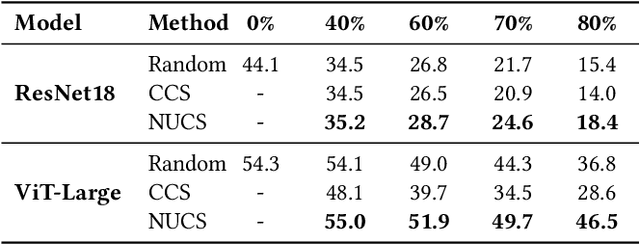

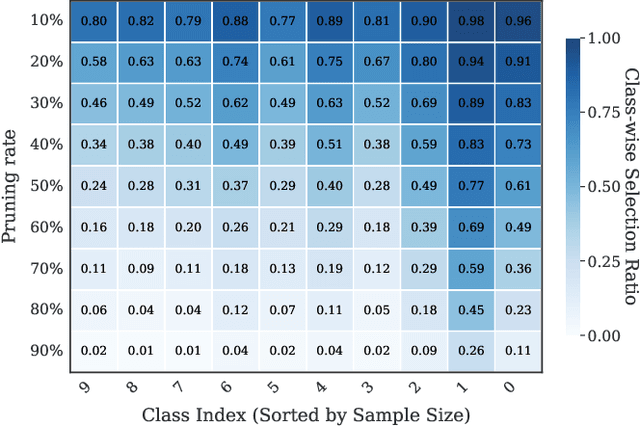
Abstract:As transfer learning models and datasets grow larger, efficient adaptation and storage optimization have become critical needs. Coreset selection addresses these challenges by identifying and retaining the most informative samples, constructing a compact subset for target domain training. However, current methods primarily rely on instance-level difficulty assessments, overlooking crucial category-level characteristics and consequently under-representing minority classes. To overcome this limitation, we propose Non-Uniform Class-Wise Coreset Selection (NUCS), a novel framework that integrates both class-level and instance-level criteria. NUCS automatically allocates data selection budgets for each class based on intrinsic category difficulty and adaptively selects samples within optimal difficulty ranges. By explicitly incorporating category-specific insights, our approach achieves a more balanced and representative coreset, addressing key shortcomings of prior methods. Comprehensive theoretical analysis validates the rationale behind adaptive budget allocation and sample selection, while extensive experiments across 14 diverse datasets and model architectures demonstrate NUCS's consistent improvements over state-of-the-art methods, achieving superior accuracy and computational efficiency. Notably, on CIFAR100 and Food101, NUCS matches full-data training accuracy while retaining just 30% of samples and reducing computation time by 60%. Our work highlights the importance of characterizing category difficulty in coreset selection, offering a robust and data-efficient solution for transfer learning.
Scaling Laws for Data-Efficient Visual Transfer Learning
Apr 17, 2025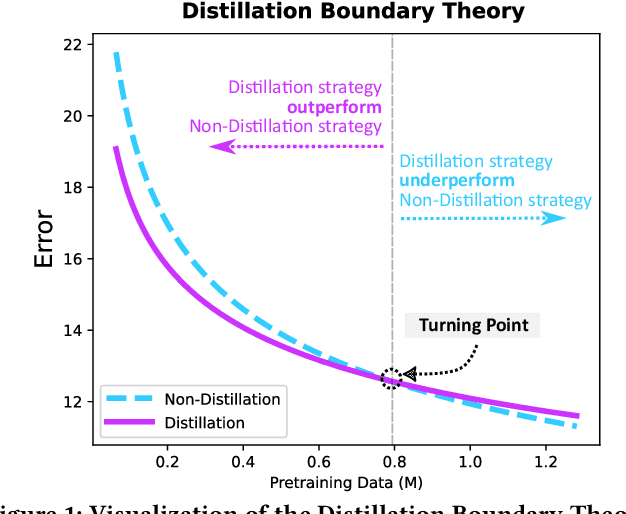
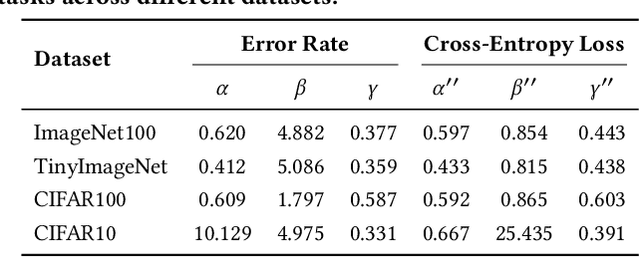

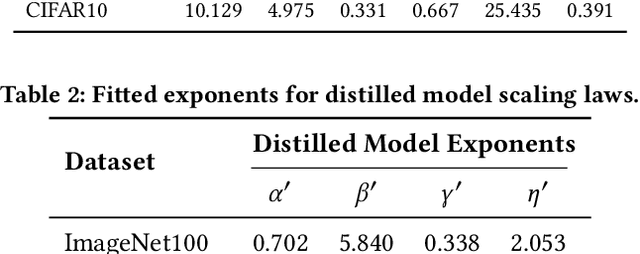
Abstract:Current scaling laws for visual AI models focus predominantly on large-scale pretraining, leaving a critical gap in understanding how performance scales for data-constrained downstream tasks. To address this limitation, this paper establishes the first practical framework for data-efficient scaling laws in visual transfer learning, addressing two fundamental questions: 1) How do scaling behaviors shift when downstream tasks operate with limited data? 2) What governs the efficacy of knowledge distillation under such constraints? Through systematic analysis of vision tasks across data regimes (1K-1M samples), we propose the distillation boundary theory, revealing a critical turning point in distillation efficiency: 1) Distillation superiority: In data-scarce conditions, distilled models significantly outperform their non-distillation counterparts, efficiently leveraging inherited knowledge to compensate for limited training samples. 2) Pre-training dominance: As pre-training data increases beyond a critical threshold, non-distilled models gradually surpass distilled versions, suggesting diminishing returns from knowledge inheritance when sufficient task-specific data becomes available. Empirical validation across various model scales (2.5M to 38M parameters) and data volumes demonstrate these performance inflection points, with error difference curves transitioning from positive to negative values at critical data thresholds, confirming our theoretical predictions. This work redefines scaling laws for data-limited regimes, bridging the knowledge gap between large-scale pretraining and practical downstream adaptation, addressing a critical barrier to understanding vision model scaling behaviors and optimizing computational resource allocation.
Data-centric Federated Graph Learning with Large Language Models
Mar 25, 2025Abstract:In federated graph learning (FGL), a complete graph is divided into multiple subgraphs stored in each client due to privacy concerns, and all clients jointly train a global graph model by only transmitting model parameters. A pain point of FGL is the heterogeneity problem, where nodes or structures present non-IID properties among clients (e.g., different node label distributions), dramatically undermining the convergence and performance of FGL. To address this, existing efforts focus on design strategies at the model level, i.e., they design models to extract common knowledge to mitigate heterogeneity. However, these model-level strategies fail to fundamentally address the heterogeneity problem as the model needs to be designed from scratch when transferring to other tasks. Motivated by large language models (LLMs) having achieved remarkable success, we aim to utilize LLMs to fully understand and augment local text-attributed graphs, to address data heterogeneity at the data level. In this paper, we propose a general framework LLM4FGL that innovatively decomposes the task of LLM for FGL into two sub-tasks theoretically. Specifically, for each client, it first utilizes the LLM to generate missing neighbors and then infers connections between generated nodes and raw nodes. To improve the quality of generated nodes, we design a novel federated generation-and-reflection mechanism for LLMs, without the need to modify the parameters of the LLM but relying solely on the collective feedback from all clients. After neighbor generation, all the clients utilize a pre-trained edge predictor to infer the missing edges. Furthermore, our framework can seamlessly integrate as a plug-in with existing FGL methods. Experiments on three real-world datasets demonstrate the superiority of our method compared to advanced baselines.
Rethinking Byzantine Robustness in Federated Recommendation from Sparse Aggregation Perspective
Jan 08, 2025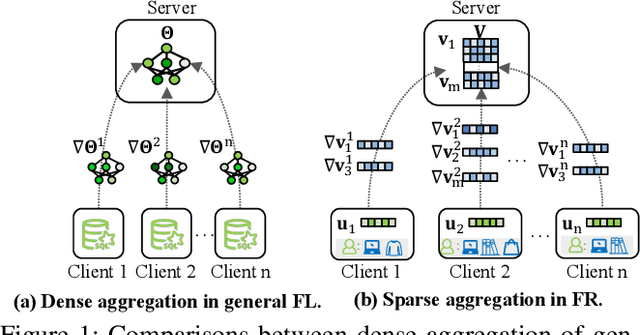


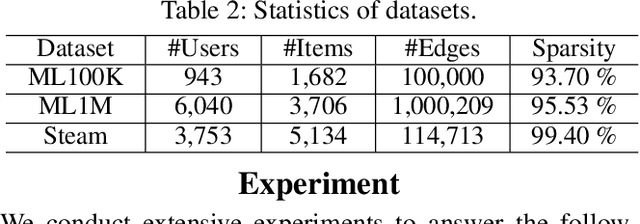
Abstract:To preserve user privacy in recommender systems, federated recommendation (FR) based on federated learning (FL) emerges, keeping the personal data on the local client and updating a model collaboratively. Unlike FL, FR has a unique sparse aggregation mechanism, where the embedding of each item is updated by only partial clients, instead of full clients in a dense aggregation of general FL. Recently, as an essential principle of FL, model security has received increasing attention, especially for Byzantine attacks, where malicious clients can send arbitrary updates. The problem of exploring the Byzantine robustness of FR is particularly critical since in the domains applying FR, e.g., e-commerce, malicious clients can be injected easily by registering new accounts. However, existing Byzantine works neglect the unique sparse aggregation of FR, making them unsuitable for our problem. Thus, we make the first effort to investigate Byzantine attacks on FR from the perspective of sparse aggregation, which is non-trivial: it is not clear how to define Byzantine robustness under sparse aggregations and design Byzantine attacks under limited knowledge/capability. In this paper, we reformulate the Byzantine robustness under sparse aggregation by defining the aggregation for a single item as the smallest execution unit. Then we propose a family of effective attack strategies, named Spattack, which exploit the vulnerability in sparse aggregation and are categorized along the adversary's knowledge and capability. Extensive experimental results demonstrate that Spattack can effectively prevent convergence and even break down defenses under a few malicious clients, raising alarms for securing FR systems.
FacialFlowNet: Advancing Facial Optical Flow Estimation with a Diverse Dataset and a Decomposed Model
Sep 09, 2024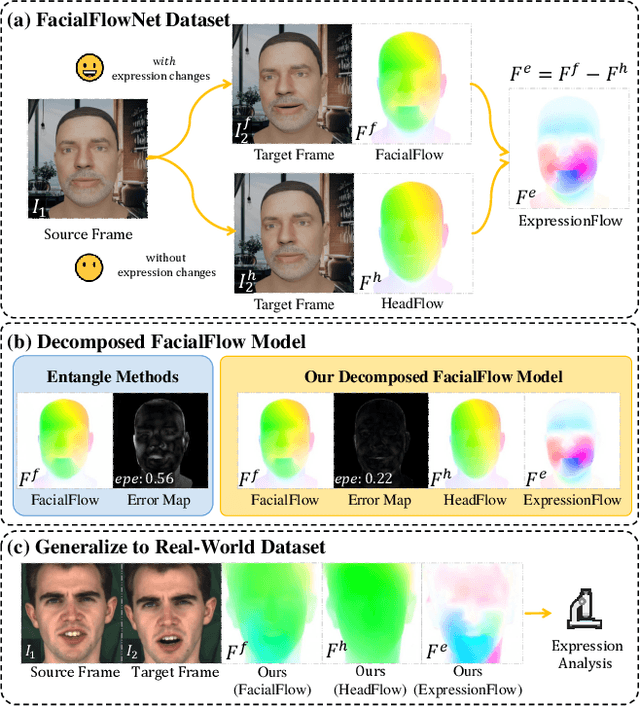

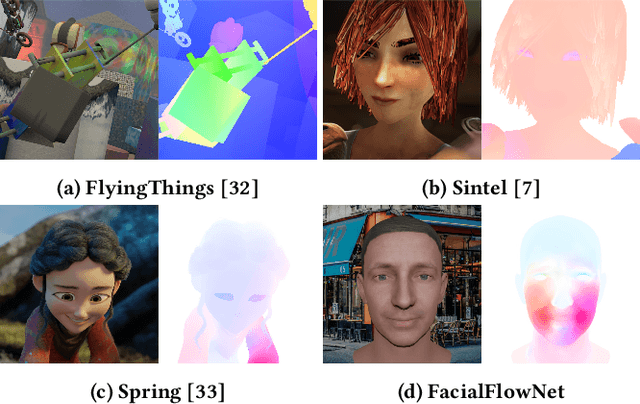
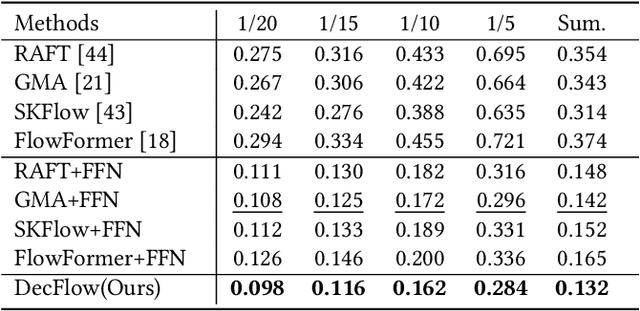
Abstract:Facial movements play a crucial role in conveying altitude and intentions, and facial optical flow provides a dynamic and detailed representation of it. However, the scarcity of datasets and a modern baseline hinders the progress in facial optical flow research. This paper proposes FacialFlowNet (FFN), a novel large-scale facial optical flow dataset, and the Decomposed Facial Flow Model (DecFlow), the first method capable of decomposing facial flow. FFN comprises 9,635 identities and 105,970 image pairs, offering unprecedented diversity for detailed facial and head motion analysis. DecFlow features a facial semantic-aware encoder and a decomposed flow decoder, excelling in accurately estimating and decomposing facial flow into head and expression components. Comprehensive experiments demonstrate that FFN significantly enhances the accuracy of facial flow estimation across various optical flow methods, achieving up to an 11% reduction in Endpoint Error (EPE) (from 3.91 to 3.48). Moreover, DecFlow, when coupled with FFN, outperforms existing methods in both synthetic and real-world scenarios, enhancing facial expression analysis. The decomposed expression flow achieves a substantial accuracy improvement of 18% (from 69.1% to 82.1%) in micro-expressions recognition. These contributions represent a significant advancement in facial motion analysis and optical flow estimation. Codes and datasets can be found.
Maximizing V-information for Pre-training Superior Foundation Models
Aug 13, 2024Abstract:Pre-training foundation models on large-scale datasets demonstrates exceptional performance. However, recent research questions this traditional notion, exploring whether an increase in pre-training data always leads to enhanced model performance. To address this issue, data-effective learning approaches have been introduced. However, current methods in this area lack a clear standard for sample selection. Our experiments reveal that by maximizing V-information, sample selection can be framed as an optimization problem, enabling effective improvement in model performance even with fewer samples. Under this guidance, we develop an optimal data-effective learning method (OptiDEL) to maximize V-information. The OptiDEL method generates hard samples to achieve or even exceed the performance of models trained on the full dataset while using substantially less data. We compare the OptiDEL method with state-of-the-art approaches finding that OptiDEL consistently outperforms existing approaches across different datasets, with foundation models trained on only 5% of the pre-training data surpassing the performance of those trained on the full dataset.
 Add to Chrome
Add to Chrome Add to Firefox
Add to Firefox Add to Edge
Add to Edge